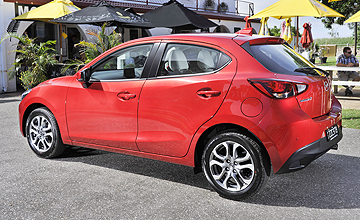BY ROBBIE WALLIS | 11th Apr 2017

That reputation has helped the Japanese brand become the second-best selling manufacturer in Australia behind Toyota, while also holding the highest market share in Australia out of any country in which it operates.
Keen to hold its position in the market, Mazda has erred on the side of caution with recent updates and new models, retaining much of what brought the company success in the first place with updates to the likes of the Mazda3, Mazda6 and CX-5.
The same approach has been applied to the Mazda2 update, with design, powertrains and pricing remaining largely untouched, and the biggest changes to safety equipment, handling and the addition of a top-spec GT variant to sit above the previously range-topping Genki.
Pricing has not changed over the previous generation, with the range kicking off from $14,990 plus on-roads or $16,990 driveaway for the base Neo manual, and topping out at $23,680 plus on-roads ($25,680 driveaway) for the range-topping GT six-speed auto.
Spotting the differences to the exterior would require a dedicated Mazda fan, with the only changes limited to redesigned folding side mirrors (automatic on high-spec variants), and shark fin antenna, silver foglight bezels and 16-inch alloys for GT and Genki variants. Four new colours have also been added to the range.
GoAuto had the chance to drive the GT six-speed auto, which like the exterior, offered mild changes to an already well laid out interior.
The updated interior features a redesigned steering wheel, a head-up display with speed limit indicator, DAB+ digital radio and white leather trim adorning the dashboard, doors, and mixed with black cloth on the seats.
Not much needed changing with the Mazda2’s interior, as it already offered an uncluttered, aesthetically pleasing experience that was easy to use and features simple, tactile functionality without an abundance of unnecessary buttons and switches.
The infotainment system is easy to use, however it is prone to some technical gremlins such as lag, poor voice recognition and glitchy Bluetooth connectivity.
Comfort and space is adequate for front seat passengers, with plenty of headroom and supportive seats. As expected for a car of this size, rear quarters are a bit cramped, and fitting three full sized adults across the back row makes for a very tight squeeze. Kids however will be fine.
The GT also offers a comprehensive suite of safety technology including five airbags, ABS, blind spot monitoring, dynamic stability control, electronic brake-force distribution, emergency brake assist, hill launch assist, rear parking sensors and reversing camera, rear cross-traffic alert and autonomous emergency braking.
It is the only light car other than the Skoda Fabia to offer AEB as standard, and its comprehensive list of safety features can help parents of P-platers rest easier.
Mazda has also made changes under the Mazda2’s skin to help its ride and handling, including revised suspension bushings, front and rear dampers, electronic power steering recalibration and the introduction of Mazda’s G-Vectoring torque control system.
The G-Vectoring addition together with the updated handling components helps to make the Mazda2 an extremely nimble and cooperative car to drive. It can be thrown into corners effortlessly and it has precise and direct steering feel.
It has always been one of the picks of the segment for driving enjoyment and it still is.
Driving around town is made easy in the GT, with its tight turning circle and small size making parking easy.
However despite its improvements, the ride in the little Mazda still leaves room for improvement. Even small bumps on the road struggle to be soaked up by the car’s suspension and tyres, and the firmness of the ride can get tedious on longer trips.
Noise, vibration and harshness (NVH) levels have improved with the addition of a noise-insulating windscreen, insulation in the engine compartment and damping material in the luggage compartment, and the GT’s cabin remains relatively quiet despite the firm ride, with minimal rattles.
The most exterior noise comes from the Mazda2’s engine, an unchanged 1.5-litre aspirated four-cylinder unit that makes 81kW/141Nm – a spirited engine that needs to work hard to get going, but is adequate for a car of its size.
The aspirated engine offers good throttle response, and works well teamed to the six-speed automatic gearbox, which makes snappy, intuitive gear changes and gives the engine extra pep when in sport mode.
Fuel economy hovers around 7.0 litres per 100km, up from 4.9L/100km on the claimed combined cycle.
At $23,680 before on-roads, the Mazda2 GT automatic is one of the most expensive light hatches on the market, if you discount the sport-focused or premium European offerings, however it also offers more standard equipment, safety features and quality inside and out than most of its rivals.
Its interior has the feel of a more expensive model, and the handling and reliability that has become synonymous with Mazda add up to make the updated Mazda2 a car that should be at the top of any light hatch buyer’s shopping list.